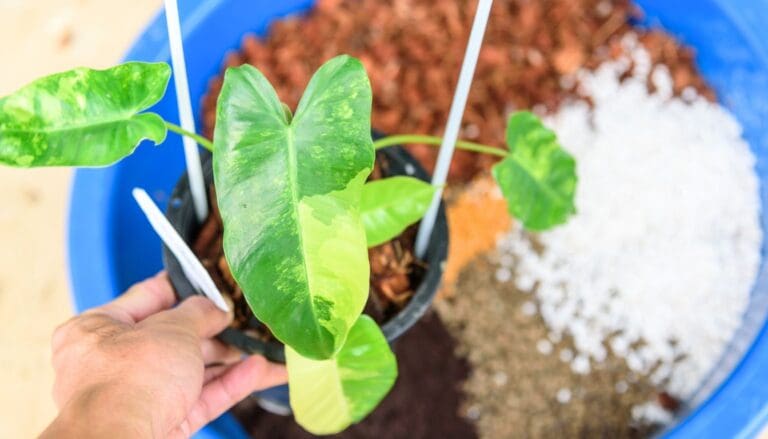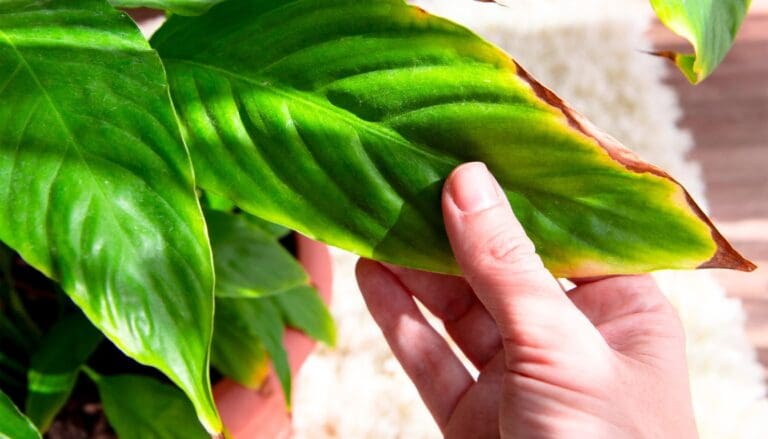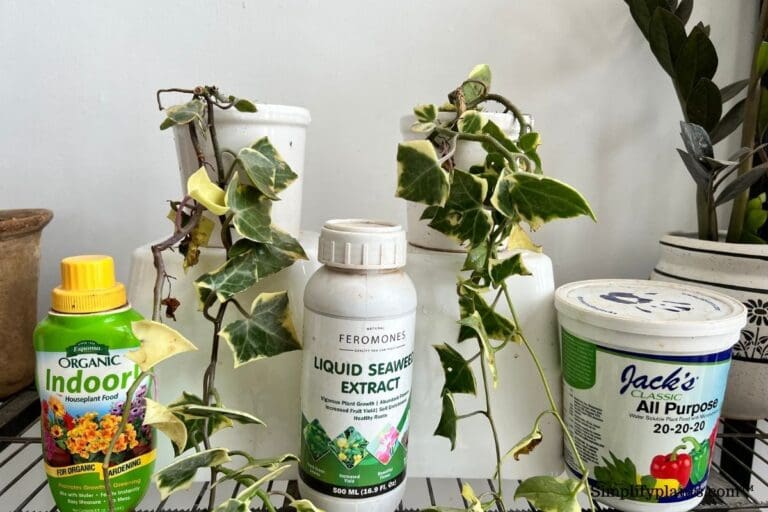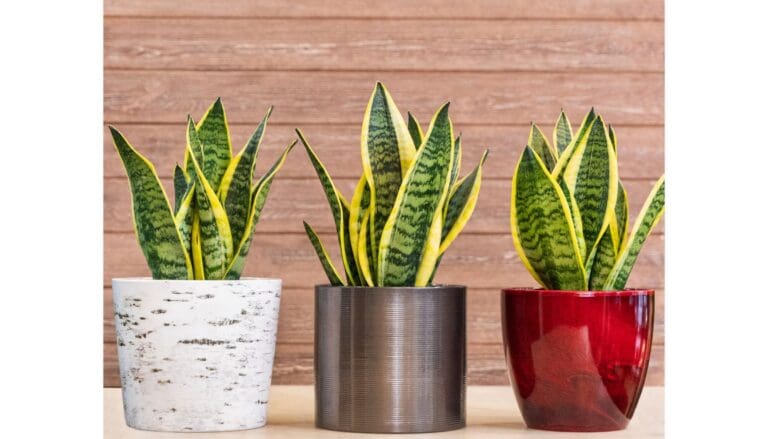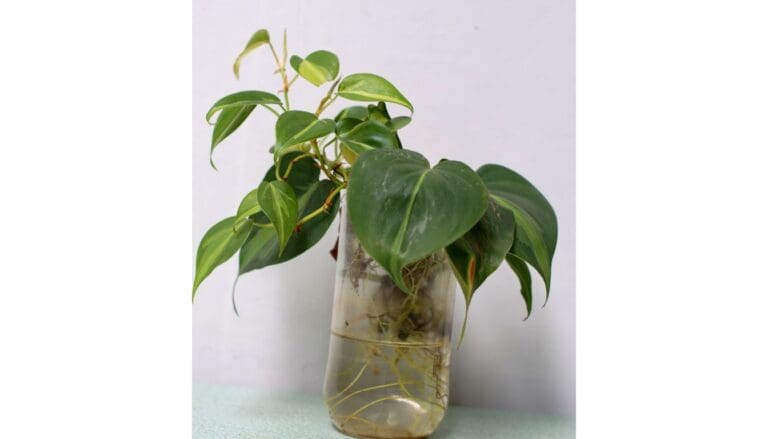Why Is My Calathea Losing Leaves? (Possible Problem+Solution)
The Calathea plant, with its stunning green foliage, can add charm to any corner of your house. At the same time, Calathea is known to have a reputation for having tricky and specific needs. Its fussy nature reaffirms the fact that this indoor plant is not for novice gardeners.
If you fail to meet their suitable conditions, the Calathea plants will firmly express their grievance by losing leaves and it can be difficult to understand why. So, in this article, we shall discuss why is my calathea losing leaves and how you can fix the same.
Incorrect watering techniques, a poor drainage system, and temperature fluctuations are the primary reasons due to which your calathea must be losing their leaves. Move the plant to medium lighting conditions, water the plant when the soil gets dry, and make sure the plant has adequate drainage.
It is crucial to figure out what is distressing your Calathea plant to prevent any loss of leaves. Let’s keep reading to identify the significant problems affecting your Calathea plant that need urgent troubleshooting.

Please note: Simplify Plants is reader-supported. Some links in the post are affiliate links and I get a commission from purchases made through links in the post.
Incorrect watering
Watering your Calathea plant incorrectly can always act as a significant reason behind the plant losing leaves rapidly. Both overwatering and underwatering over long periods can equally harm your Calathea leaves.
Causes
Often, planters can make the mistake of not taking the water requirements of their Calathea plants seriously. And this neglect naturally leads to the loss of Calathea leaves.
Underwatering: When you underwater your Calathea, its roots start to suffer due to a lack of water. It is this water, which aids in the transfer of all the nutrients to stems and leaves. Due to the loss of all strength and moisture, the leaves shrivel and fall off.
Overwatering: The Calathea plant has a strong preference for slightly moist soil with consistent texture. Remember to not overwater the plant out of the desire for fast growth.
Making them stay in a soggy and overwatered pot for too long can result in the deadly root rot disease. The excess water will restrict Calathea from absorbing the necessary nutrients.
Also, yellow scars will appear on the leaves, and they will fall off, and you might lose your Calathea plant forever.

Solution
Underwatering can be remedied by following the given steps:
- Before supplying your Calathea with a drink, be sure to check the soil’s moisture level with a moisture meter.
- Choose a clean alternative like distilled or rainwater at room temperature for watering your Calathea plants, as tap water contains chlorine and other mineral toxins.
- Soak your Calathea plant in water for a duration depending on the moisture content.
- You can consider a self-watering planter for your Calathea plant since it usually drinks at the root zone.
The overwatered calathea can be fixed with the following steps:
- Make sure to use a well-draining soil mixture in place.
- Calatheas can lose leaves when they don’t receive enough light for processing the water it absorbs. Allow your Calathea plant to dry naturally by placing it near a source of bright indirect light.
- Cut off any decaying and damaged branches and leaves to replenish your Calathea.
- Run checks on the drainage system to see if the extra water is getting drained properly.
- Always check the soil with your fingers and water if only it feels dry.
- If the overwatering situation goes out of hand and a bacterial or fungal infection occurs, you must remove all the affected roots and repot the plant in a new soil mix.
Also read: How Often To Water Calathea? (A Complete Calathea Watering Guide)
Insufficient light
The white and green Calathea plants lose most of their variegation in low light. On the other hand, the red varieties do pretty well in lower light exposure.
Calathea plants tend to thrive best with bright indirect light. You should note that the active leaves of a Calathea are sensitive to changes in light.
The direct and scorching sun can burn the leaves and cause discoloration. You can move the Calathea slightly away, about 2-3 feet away from the window, for a more balanced light intensity.
Causes
In low light conditions, the photosynthesis process slows down. Chlorophyll production starts decreasing, and the leaves start moving towards exhausting all of their energy.
Then, the leaves start dropping and finally fall off.
Light regulates the utilization of all the food and water your Calathea receives. Naturally, in the scarcity of light, the plant fails to use the available resources of food and water. This hinders their overall growth.
Without the warmth and heat of the light, the soil will also remain wet for longer, and fungal growth may appear.
This situation usually occurs at the approach of winter, when the sun is mild and water doesn’t evaporate easily. All of these conditions ultimately lead to leaf loss.
Solution
- The ideal place for the Calathea plant is around 2-metres away from the south or east-facing window. While the light coming from west-facing windows can be too harsh, north-facing windows can be too mild.
- Although Calathea can grow in low light conditions, the plants cannot tolerate direct sunlight at all.
- During summer, find a spot for your Calathea where it can get a minimum of 10 hours of bright, indirect light with 8 hours of darkness. This will guarantee optimal sprouting of leaves.
- You can move your Calathea outdoor for adequate light in the winter for a short while. But they have to be moved back inside to protect them from frost.
- Using artificial light sources like lamps can help fulfill the light needs of your Calathea.
- If your Calathea is located in a dark corner, you can strategically use a mirror to redirect the bright light from nearby windows.
- Rotate your Calathea routinely during watering to prevent one side of the plant from receiving more light than the others.
Also read: How Much Light Do Calathea Plants Need? (Calathea Plant Light Requirements)
Poor drainage

Drainage is one of the vital factors concerning the healthy growth of indoor plants. Poor drainage can bring about problems like stagnant and stinky water and mildew.
Even if you properly water your Calathea, it can still end up being overwatered. This kind of overwatering can only be attributed to a poor drainage system.
Without water escaping, the soil will eventually turn soggy, and the roots will develop root rot.
Causes
Keeping the Calathea plant in a sealed container will cause poor drainage as the pot must have holes for water to escape. Even healthy Calathea and the ideal soil can fail to do well in the presence of drainage problems.
Drainage problems can make it challenging for Calathea plants to do well, and it can cause overwatering issues that can become a lot worse.
The calathea plants that have poor drainage systems are easy victims of overwatering. It will also deter the transportation of nutrients and water throughout the plant.
Roots and soil will fail to absorb nutrients, and the Calathea plant will lose its leaves rapidly.
The sudden loss of leaves points to a looming overwatering and root situation. You must take immediate action to improve the drainage.
Solution
The following needs to be done to fix the drainage system:
- Do not water the plant till the soil is completely dry.
- Carry out a thorough inspection of the drainage system of the pot. The excess water should drain within a few minutes of watering if the drainage system is working fine.
- Put a layer of gravel, pebbles, broken pottery at the bottom of the Calathea to absorb the extra water.
- A well-draining soil will also speed up the process of water draining out quickly.
- Activated charcoal can also serve as an effective natural absorbent. In addition to that, it has antimicrobial properties which help your Calathea plants to fight against bacterial diseases.
- You can drill holes into your pot to facilitate the timely movement of water.
- If nothing works, shift your Calathea to another pot that has working drainage holes.
The wrong type of soil

As we all know, the ultimate source of nutrients and water for plants is the soil. Thus, planting the Calathea in the wrong soil can have highly adverse effects.
Causes
Your Calathea plants will undergo various issues if it is forced to grow in unsuitable soil.
Extremely dry soil will make the leaves go yellow and fall off over time. It can happen as soon as you miss out on watering twice. Due to this, the soil will lack the required nutrients.
Both non-retention of moisture and over retention is detrimental for the Calathea plant.
Also, heavy soil will form an ideal scenario for root rot and fungal infections. As a result, the leaves will no longer maintain their original vibrance, vigor, and firmness.
Various varieties of soil are too thick for draining out the water efficiently. The perfect soil type for Calathea plants is well-aerated and well-draining soil that is a little fluffy.
Solution
If the existing soil mix is heavy, repot your Calathea with the right potting mixture.
- Always opt for a well-draining soil mix.
- The ideal potting mixture for your calathea will have 50% potting soil, 20% orchid bark, 20% activated charcoal, and 10% perlite.
- Coarse materials like bark and vermiculite will improve the aeration of the soil.
- Try to ensure that the potting soil has a pH of 6.5. Agricultural limestone will help to increase the pH if the soil is too acidic. And if you need to lower the pH, use pine needles or peat moss.
- Add organic materials like compost and mulch to loosen the compact soil.
- Feed a diluted nitrogen-rich fertilizer to your Calathea plant if it is not fertilized correctly.
- Remember to water the plant before fertilizing for an even distribution of nutrients in the soil.
Also read: What Kind Of Soil Is Best For Calathea? (Best Soil Mix For Calathea)
Pest infestation
Calathea plants are most vulnerable to attacks by spider mites. But even other pests can cause infestations, such as mealybugs, aphids, and scales.
Causes
Calathea plants can be affected by stubborn spider mites primarily because the environment might not be as moist as they prefer. Spider mites are drawn to dry conditions.
In contrast, mealybugs and aphids find their way to moist areas. They even start multiplying in those conditions, completely ravaging your plant. Thus, you must be careful when it comes to the watering and drainage of the plant.
Placing other newly bought plants with existing pest infestations close to your Calathea can infect it.
These pests thrive on taking in all the energy of the plant, leaving it weak. The leaf foliage starts browning, wilting, getting stunted, and then falls off.
Solution
- Keep the newly bought plants in isolation until they show no signs of a pest infestation before moving them close to your existing Calathea.
- You can use your hands to remove as many bugs as you can.
- Make a neem oil spray by mixing 2 spoons of neem oil into one-gallon water and spraying it on the plant every day.
- Take a cotton ball, soak it in rubbing alcohol, and wipe your Calathea leaves with it to eliminate the tiny bugs.
- Insecticidal soaps and horticultural oils can help in dealing with pests, but follow-up treatments are needed.
- Only if the infestation is getting out of hand can you turn to chemical pesticides. Always read the instruction manual before buying and dilute it.
- Misting can help to protect the plant from bugs. A weekly shower can remove all the dust that might breed pests. Remember to keep this washing during watering periods to avoid overwatering.
Temperature fluctuations

Abrupt temperature changes will stress out your Calathea, which will lead to the loss of leaves.
Causes
Calathea doesn’t tolerate a wide variety of temperature ranges. Low temperatures can significantly stress Calathea. You need to protect the plants if a dip in the temperature is at bay.
Calathea plants never react well to extreme or sudden temperature shifts. Calatheas must be kept at a temperature range between 65-80°F.
A temperature-controlled environment where you can turn the thermostat to a standard of 70°F will ensure the healthy growth of Calathea.
Calathea plants also do not take a liking to heat sources like heaters.
The leaves will fall off as a sign of shock if the Calathea is exposed to temperature fluctuations for a prolonged time.
Solution
- Try not to move your Calathea plant from one place to another frequently.
- Keep the plants far away from radiators, vents, and furnaces.
- Ensure that they stay in a ventilated area always.
- To shield Calathea from frost during the winter months, don’t keep them close to the drafty doors and windows.
Also read: What Temperature Can Calathea Tolerate? (Ideal Temperature Range)
Low Humidity
Like all tropical plants, Calatheas need 50-70% of humidity to grow well. If they stay in close contact with dry air, the plant’s leaves will start yellowing and falling.
In the winter months, the air gets quite dry in places throughout North America. This will make it essential to increase the humidity levels.
Solution
- You can use a portable humidifier to raise the humidity in the rooms. If that seems inadequate, you could also set up a whole-house humidifying system.
- Grouping a bunch of tropical plants will also help to increase the local humidity. But, here, you have to see that too much crowding doesn’t happen.
- Placing water-filled trays near your Calathea can raise the humidity. You can even place a few upturned seashells on the soil to store water under the leaves.
- A light misting on the Calathea leaves will not make a big difference to the overall humidity but would still offer a little boost.
Also read: Should I Mist My Calathea Plant? (Calathea Humidity Requirements)
Older leaves falling off.

All plants lose their lower leaves as they grow older and more mature. The leaves falling due to old age is not a problem, but something natural.
Your Calathea can lose several leaves when the lifespan of these leaves comes to an end.
Causes
The Calathea losing leaves is a part of the plant’s life cycle.
New growth replaces the leaves that fall in the growing season. Only if the fall of leaves appears out of the normal, you need to investigate further.
Solution
1. Look for the possible reasons stressing your Calathea.
2. Check on your Calathea to track the typical leaf dropping rate.
3. Proceed to take action if the leaves are dropping excessively.
Will Calathea leaves grow back?
The leaves that fall off the Calathea once or turn yellow/brown would not become healthy again. Calathea plants make a comeback and produce fresh leaves, even after losing several leaves in a row.
As soon as the plant gets acclimated to new conditions, it will increase with renewed vigor. You can do the following to encourage the growth of new branches and leaves:
1. Prune your Caleathea plant in stages during early spring.
2. Use your fingers to pinch back young stems to stimulate new leaf growth.
3. Ensure that your plant gets enough bright indirect light to increase growth.
4. Fertilizing with a nitrogen-rich fertilizer in the early summer will help produce new leaves and stems.
Final words
Calathea plants are popular indoor plants that are relatively easy to care for. But you still need to keep a close eye on your Calathea and monitor every minor and major change it goes through.
If you successfully consider all the factors in caring for a calathea plant, you can prevent them from losing any leaves in time. Since there are diverse reasons that can cause the leaves to fall off, initially, you might find it challenging to figure out what’s wrong.
The best thing to do then is to keep your patience and research the signs your Calathea plant shows to determine the root problem.
Source: NCBI, University of Florida, Wikipedia, Growing Indoor Plants with Success, Agriculture, and Natural Resources, University of California, Missouri Botanical Garden.
Recommended Garden Supplies
| Product Image | Our Recommended Gardening Supplies | Check Offers! |
|---|---|---|
Top Top
Top
Top
Top
Top
Top
Top
Top | rePotme Houseplant and Tropical Classic Potting Soil Mix | Check Offer On Amazon |
 Top
Top
Top
Top
Top
Top
Top
Top | Espoma Organic Indoor Plant Food | Check Offer On Amazon |
 Top
Top
Top
Top
Top
Top
Top
Top | GooingTop LED Grow Light 6000K Full Spectrum Clip Plant Growing Lamp | Check Offer On Amazon |
 Top
Top
Top
Top
Top
Top
Top
Top | Soil Moisture Meter | Check Offer On Amazon |
 Top
Top
Top
Top
Top
Top
Top
Top | Govee Hygrometer Thermometer, Bluetooth Enabled! | Check Offer On Amazon |
 Top
Top | LEVOIT Humidifiers for Large Room(Best For Plants) | Check Offer On Amazon |
 Top
Top
Top
Top
Top
Top
Top
Top | Upgraded DIY Automatic Drip Irrigation Kit, 15 Potted Houseplants Support | Check Offer On Amazon |
 Top
Top
Top
Top
Top
Top
Top
Top | Stainless Steel Heavy Duty Gardening Tool Set | Check Offer On Amazon |
 Top
Top
Top
Top
Top
Top
Top
Top | Bonide Insecticidal Soap | Check Offer On Amazon |
 Top
Top
Top
Top
Top
Top
Top
Top | Bonide 32 oz Spray Neem Oil for Organic Gardening | Check Offer On Amazon |
 Top
Top
Top
Top
Top
Top
Top
Top | Garden Safe Fungicide | Check Offer On Amazon |

